BP Bundle
How is BP Reshaping Its Sales and Marketing in the Energy Transition?
BP, a titan of the energy sector, is undergoing a dramatic transformation. From its 'Beyond Petroleum' rebranding to its recent strategic 'reset' in February 2025, BP's sales and marketing approach reflects a company in flux. This analysis dives deep into the evolving BP SWOT Analysis, exploring how it navigates a complex market.
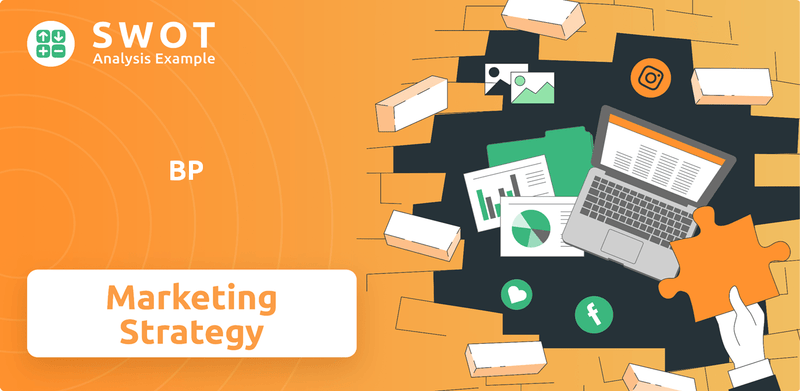
This examination will dissect BP's BP sales strategy and BP marketing strategy, revealing the core principles driving its BP strategy. We'll explore its BP marketing plan, evaluate BP sales performance, and analyze its evolving BP business model in the context of a shifting energy landscape. Understand how BP is adapting its BP sales and marketing approach to stay competitive, examining its BP marketing strategies for renewable energy and BP's sales tactics for oil and gas to understand its future path.
How Does BP Reach Its Customers?
The sales channels of BP are diverse, encompassing both traditional and digital avenues to reach a broad customer base. The company's strategy includes physical retail locations, direct sales teams, and wholesale distributors. This multi-channel approach enables BP to address diverse energy needs across various markets globally, operating in over 70 countries.
BP's sales strategy has evolved, reflecting a shift towards meeting changing consumer demands and the energy transition. This includes innovations in its U.S. fuel and convenience stations, such as a new consumer digital app and cloud-based point-of-sale technology. The company is also expanding its BP Pulse EV charging operations, with plans to invest significantly in EV charging infrastructure.
Key partnerships also play a significant role in BP's sales strategy. Collaborations with Lightsource BP and others expand its presence in the solar energy market. Additionally, strategic alliances with tech companies like Microsoft and Infosys enhance digital capabilities and operational efficiency. In India, a joint venture with Reliance Industries aims to create a leading fuels and mobility company, enhancing BP's presence in a growing market.
BP utilizes physical retail locations, branded service stations, and direct sales teams for large industrial clients. These channels cater to immediate consumer needs and large-scale industrial demands. Direct sales are particularly important for aviation fuel (Air BP) and other specialized products.
Digital channels are becoming increasingly important for BP's sales and marketing approach. The company is investing in digital apps, cloud-based POS systems, and EV charging infrastructure. These innovations aim to improve the customer experience and meet the growing demand for integrated digital solutions.
BP uses wholesale distributors for products like Castrol lubricants, expanding its market reach. Strategic partnerships, such as those with Lightsource BP and Reliance Industries, also play a key role. These partnerships support expansion into renewable energy and emerging markets.
With a global presence in over 70 countries, BP adapts its sales strategies to local market conditions. This includes tailoring its approach to meet diverse energy needs and consumer preferences. The company's adaptability is crucial for maintaining sales performance.
BP's sales strategy is multifaceted, combining traditional and digital channels to optimize its market reach. The company focuses on enhancing customer experience through digital innovations and strategic partnerships. These elements are crucial for achieving sustainable sales growth and adapting to the energy transition.
- Digital Transformation: Investing in digital platforms, such as the BP app and cloud-based POS systems, to improve customer experience and operational efficiency.
- EV Charging Expansion: Significant investment in EV charging infrastructure, with plans to deploy over 100,000 charge points globally by 2030.
- Strategic Partnerships: Collaborations with companies like Lightsource BP and Reliance Industries to expand into renewable energy and emerging markets.
- Market Adaptation: Tailoring sales strategies to local market conditions and consumer preferences across its global operations.
The Growth Strategy of BP involves a comprehensive approach to sales and marketing. The company's focus on digital transformation, expansion of EV charging infrastructure, and strategic partnerships are key components of its BP sales strategy. BP's marketing plan also includes adapting to local market conditions and consumer preferences, which is critical for maintaining and improving BP sales performance. The company’s business model leverages a diverse portfolio of sales channels to meet evolving customer demands and support its overall growth objectives.
BP SWOT Analysis
- Complete SWOT Breakdown
- Fully Customizable
- Editable in Excel & Word
- Professional Formatting
- Investor-Ready Format
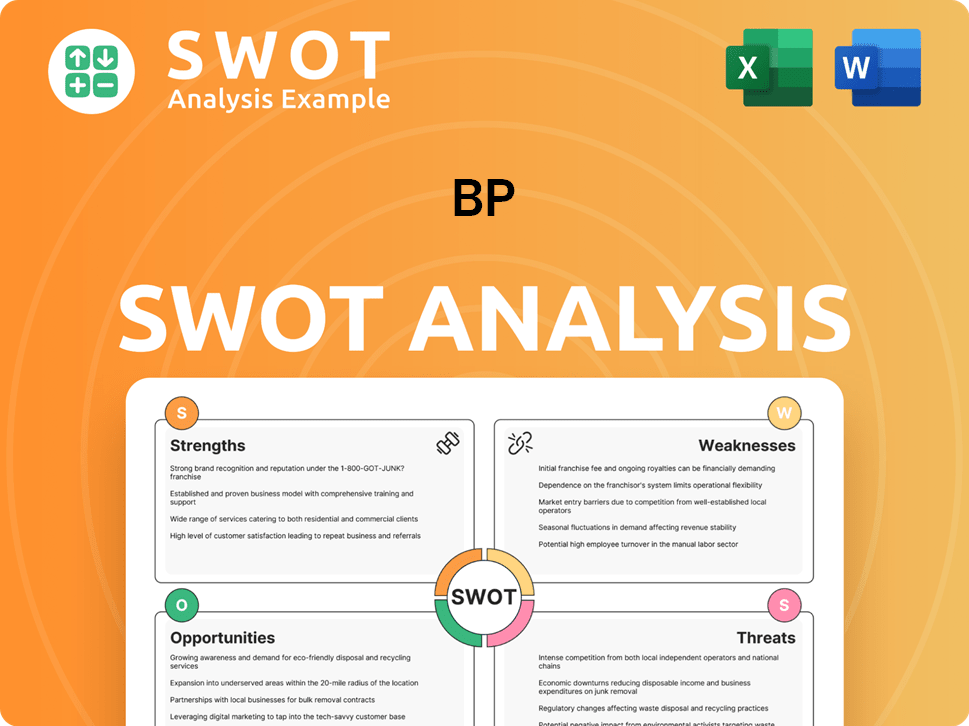
What Marketing Tactics Does BP Use?
The company employs a multifaceted approach to marketing, blending digital and traditional methods to boost brand recognition, generate leads, and drive sales. This strategy is crucial for navigating the evolving energy landscape and addressing its brand image. The company's focus is on adapting to changing consumer preferences and market dynamics.
Digital marketing is a cornerstone of the company's strategy, utilizing social media, content marketing, and online advertising to reach a wide audience. Simultaneously, traditional media like TV, radio, and print ads are used to maintain product visibility and enhance brand value. These tactics are supported by data-driven insights and customer segmentation to create targeted campaigns.
The company also leverages data analytics and AI to optimize its operations and enhance energy efficiency, including collaborations with tech companies like Microsoft. This integrated approach ensures that the company remains competitive and responsive to market demands, focusing on sustainability and the energy transition.
The company uses social media, content marketing, and online advertising to engage with a broad audience. Email marketing campaigns are also employed to communicate directly with consumers. Data-driven marketing and personalization are key elements of their digital strategy.
Traditional media like TV, radio, and print advertisements are used to increase product visibility and enhance brand value. Events, such as the BP Amoco Marketers Association Convention, also play a role in introducing new consumer experience initiatives.
The company invests in digital technologies, data analytics, and AI to optimize operations, enhance energy efficiency, and reduce emissions. This includes leveraging cloud computing and AI capabilities in partnership with tech companies.
The marketing mix has evolved to reflect the energy transition strategy. Brand communication increasingly focuses on sustainability and its role in the energy transition, with purpose-driven marketing campaigns highlighting initiatives in reducing carbon emissions and promoting renewable energy.
The company's marketing campaigns increasingly highlight its initiatives in reducing carbon emissions and promoting renewable energy. This is particularly aimed at environmentally conscious consumers. The company is adapting its strategies to reflect the growing importance of sustainability.
The company has developed innovations like Castrol ON, a range of advanced e-fluids for electric vehicles, supporting the growing EV market. This demonstrates the company's commitment to adapting to new technologies and consumer needs.
The company's marketing strategy is designed to support its Owners & Shareholders of BP, focusing on a blend of digital and traditional approaches. The company's digital efforts include social media campaigns, content marketing, and online advertising, while traditional methods involve TV, radio, and print ads. Data-driven marketing, customer segmentation, and personalization are key. The company is investing in digital technologies, data analytics, and AI to optimize operations. The marketing mix is evolving to reflect the company's energy transition strategy, with a focus on sustainability and renewable energy. The company's sales and marketing approach is designed to improve its sales performance and drive sales growth.
The company's marketing strategies are multifaceted, encompassing digital, traditional, and data-driven approaches. These strategies are designed to build brand awareness, generate leads, and drive sales while adapting to the evolving energy landscape.
- Digital Marketing: Utilizes social media, content marketing, email campaigns, and online advertising.
- Traditional Marketing: Employs TV, radio, and print advertisements to enhance brand value.
- Data-Driven Marketing: Leverages data analytics and AI to optimize operations and personalize customer experiences.
- Sustainability Focus: Highlights initiatives in reducing carbon emissions and promoting renewable energy.
- Innovation: Develops new products like Castrol ON to support the EV market.
BP PESTLE Analysis
- Covers All 6 PESTLE Categories
- No Research Needed – Save Hours of Work
- Built by Experts, Trusted by Consultants
- Instant Download, Ready to Use
- 100% Editable, Fully Customizable
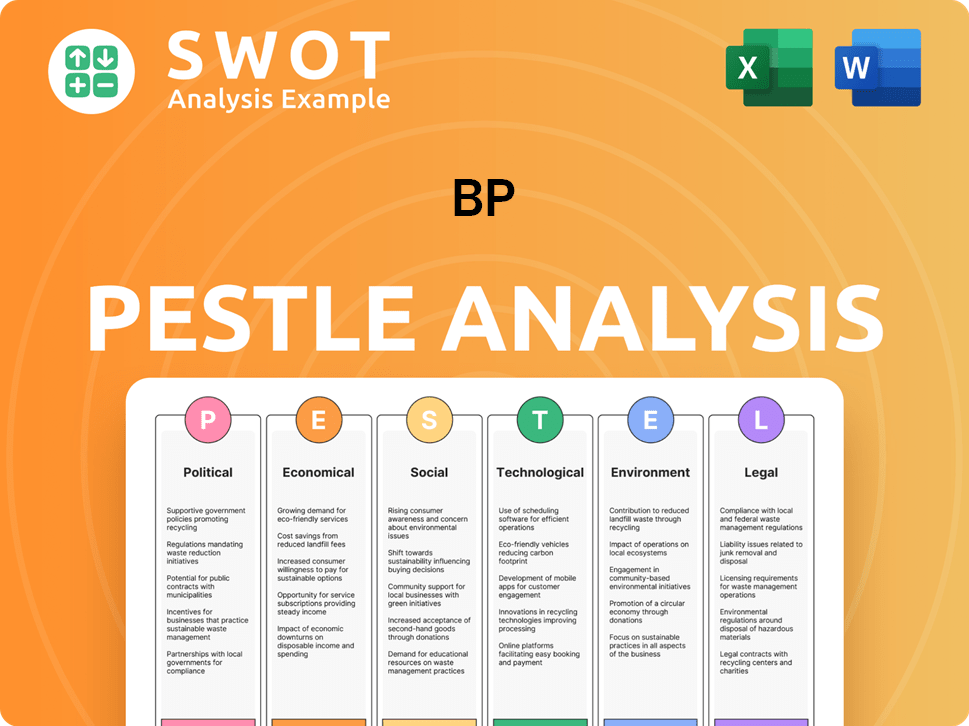
How Is BP Positioned in the Market?
The brand positioning of BP centers on its ambition to lead the energy transition, balancing its traditional oil and gas operations with a commitment to sustainability. This strategy aims to portray the company as forward-thinking, optimistic, and dedicated to driving positive change in the energy sector. The core message emphasizes BP's role in providing energy while addressing global energy needs with fewer emissions, which is a key element of its Target Market of BP strategy.
BP differentiates itself through innovation, global reach, and community engagement, targeting both individual consumers and large corporations. The company aims to build trust and credibility by showcasing its commitment to innovation and responsibility, particularly in its transition to cleaner energy sources. This approach is crucial for maintaining a strong brand image in an evolving market.
Brand consistency is maintained across various channels, with a strong emphasis on communicating its sustainability initiatives. The company's success in enhancing its brand will depend on its ability to deliver on its sustainability promises and effectively manage its dual role in both fossil fuels and renewable energy. This dual role presents both opportunities and challenges for BP's brand perception.
BP's core message focuses on providing energy while reducing emissions. This dual focus aims to meet global energy needs sustainably. The company emphasizes its role in driving positive change in the energy sector.
The 'Helios' logo symbolizes the sun and energy in all forms. This visual identity reinforces BP's commitment to renewable energy. It is a key element of their
BP targets both individual consumers and large corporations. The company offers tailored product solutions to meet diverse needs. This approach supports its
BP aims to achieve net-zero emissions by 2050 or sooner. The company plans to reduce its carbon footprint across all operations. This includes heavy investments in renewable energy.
BP faces the challenge of reconciling past environmental issues with future ambitions. Brand perception data in 2024 indicates that oil and gas employer brands like BP are recognized for employing top talent in the industry, with 80% of respondents in its home market agreeing. The company's success depends on its ability to deliver on sustainability promises. This involves effectively managing its dual role in fossil fuels and renewable energy.
- Transitioning to cleaner energy sources.
- Managing the dual role in fossil fuels and renewables.
- Maintaining brand consistency across all channels.
- Meeting ambitious net-zero emissions targets.
BP Business Model Canvas
- Complete 9-Block Business Model Canvas
- Effortlessly Communicate Your Business Strategy
- Investor-Ready BMC Format
- 100% Editable and Customizable
- Clear and Structured Layout
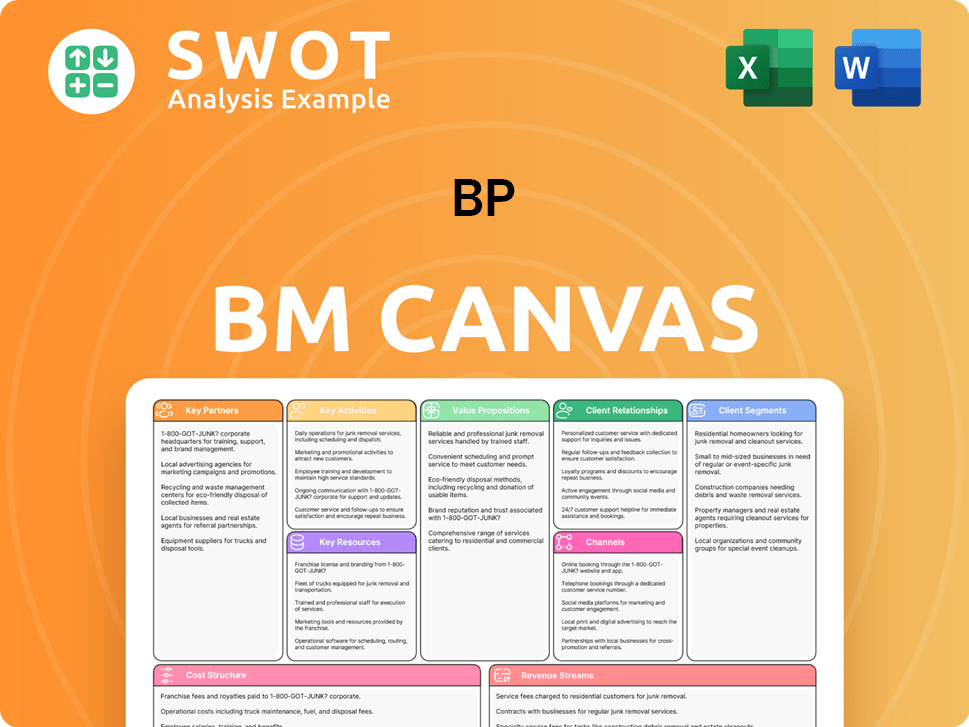
What Are BP’s Most Notable Campaigns?
The sales and marketing strategies of BP have evolved significantly, reflecting changes in the energy sector and the company's strategic goals. These strategies aim to enhance brand perception, drive sales, and align with the global shift toward sustainable energy solutions. Key campaigns have played a crucial role in reshaping how BP is perceived by both consumers and investors.
Historically, BP's marketing efforts have been focused on communicating its commitment to sustainability and innovation. Recent campaigns emphasize renewable energy, electric vehicle infrastructure, and sustainable fuels. These initiatives are designed to resonate with a broad audience and demonstrate BP's leadership in the energy transition. BP's approach involves a combination of traditional and digital media to effectively reach its target audience.
BP's sales and marketing approach includes a strong focus on digital channels and partnerships to boost sales performance. The company leverages digital platforms to enhance customer engagement and promote its products and services. Collaborations with various organizations also support BP's marketing objectives, reinforcing its commitment to social responsibility and environmental sustainability. These strategies are part of a broader effort to adapt to changing market dynamics and consumer preferences.
Launched in the early 2000s, the 'Beyond Petroleum' campaign was a pivotal sales and marketing strategy, marking a shift from traditional oil and gas to a broader energy company. This rebranding initiative included a new green and yellow 'Helios' logo, symbolizing energy in various forms. The campaign aimed to signal BP's commitment to renewable energy and environmental sustainability, influencing its business model and marketing plan.
The 'Reimagining Energy' campaign, launched in 2024, underscores BP's commitment to the energy transition. This campaign highlights investments in renewable energy technologies, such as solar and wind energy, electric vehicle charging infrastructure, and sustainable fuels. Through compelling storytelling and visual content, BP aims to enhance its brand perception as a forward-thinking energy leader. This is a key element of its BP marketing strategy.
Central to BP's brand strategy is the 'Net-Zero by 2050' campaign, showcasing its vision for a low-carbon future. This campaign emphasizes BP's leadership in the energy transition through a mix of traditional and digital media. The messaging is designed to resonate with investors and the general public, reinforcing BP's commitment to sustainability. This is a critical component of BP's marketing plan.
In February 2024, BP announced initiatives to transform the consumer experience at its fuel and convenience stations in the U.S. This includes the launch of a new consumer digital app and the expansion of BP Pulse EV charging operations. These initiatives reflect BP's strategic focus on evolving consumer needs and the growing electric vehicle market. This aligns with BP's sales growth strategies.
BP's support for the 'In Our Backyard' campaign in February 2024 demonstrates its commitment to social responsibility. This campaign focuses on combating human trafficking. This initiative is an example of BP's integrated sales and marketing approach, aiming to rebuild trust and align public perception with its evolving strategic direction.
BP's digital marketing strategy includes a new consumer digital app, enhancing customer engagement and promoting its products and services. The company's focus on digital channels is a key element of its modern marketing approach. This digital focus supports BP's sales process optimization and its broader sales and marketing approach.
BP is expanding its BP Pulse EV charging operations, reflecting its strategic focus on the growing electric vehicle market. This expansion is a key component of BP's marketing strategies for renewable energy. This initiative enhances BP's competitive marketing analysis and its position in the energy transition.
The 'Net-Zero by 2050' campaign and other initiatives highlight BP's commitment to sustainability. This focus is central to BP's marketing strategies for sustainability. Sustainability is a core element of BP's business model and its target audience for marketing.
BP collaborates with partners, such as its support for the 'In Our Backyard' campaign. These partnerships are crucial for aligning public perception with BP's strategic direction. Collaborations support BP's marketing objectives and enhance its brand visibility.
The success of BP's campaigns is measured not only in brand visibility but also in their ability to rebuild trust. This is a critical aspect of BP's sales performance. These efforts aim to align public perception with BP's evolving strategic direction, which is a key element of BP's sales and marketing approach.
While specific sales lift or engagement metrics for recent initiatives are not publicly detailed as campaign results, the focus on the energy transition and digital engagement is evident. BP's marketing budget allocation reflects its strategic priorities. The company's approach involves adapting to changing market dynamics and consumer preferences. To learn more about the company, you can read this article: 0
- Reimagining Energy Campaign: This campaign highlights BP's investments in renewable energy technologies.
- Digital Initiatives: The launch of a new consumer digital app and the expansion of EV charging operations.
- Sustainability Focus: The 'Net-Zero by 2050' campaign showcases BP's vision for a low-carbon future.
- Partnerships: Collaborations like the 'In Our Backyard' campaign support social responsibility.
BP Porter's Five Forces Analysis
- Covers All 5 Competitive Forces in Detail
- Structured for Consultants, Students, and Founders
- 100% Editable in Microsoft Word & Excel
- Instant Digital Download – Use Immediately
- Compatible with Mac & PC – Fully Unlocked
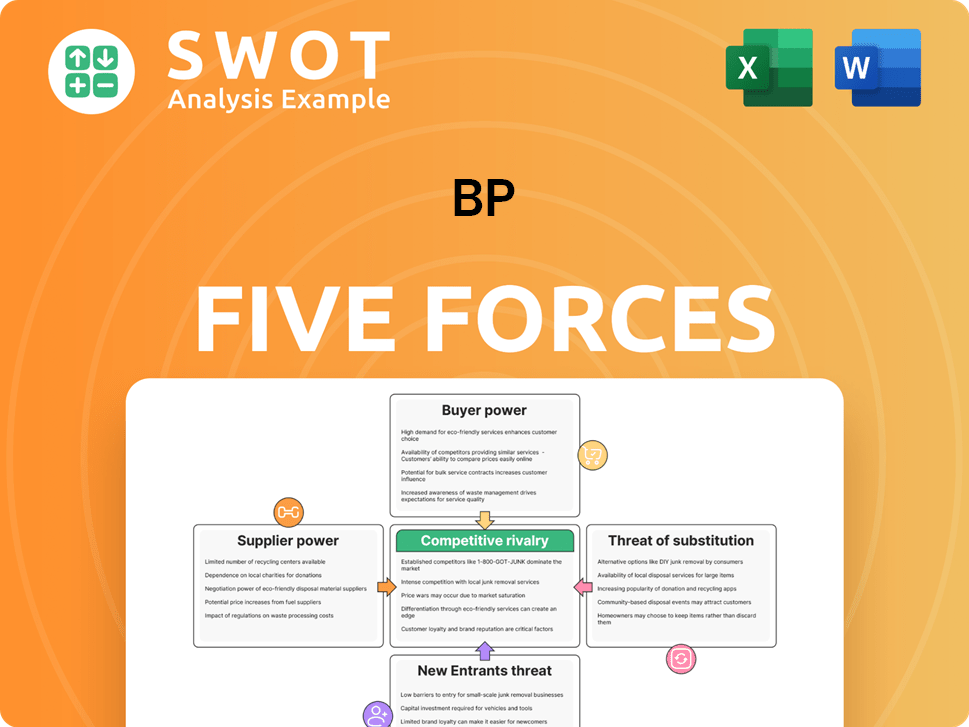
Related Blogs
Disclaimer
All information, articles, and product details provided on this website are for general informational and educational purposes only. We do not claim any ownership over, nor do we intend to infringe upon, any trademarks, copyrights, logos, brand names, or other intellectual property mentioned or depicted on this site. Such intellectual property remains the property of its respective owners, and any references here are made solely for identification or informational purposes, without implying any affiliation, endorsement, or partnership.
We make no representations or warranties, express or implied, regarding the accuracy, completeness, or suitability of any content or products presented. Nothing on this website should be construed as legal, tax, investment, financial, medical, or other professional advice. In addition, no part of this site—including articles or product references—constitutes a solicitation, recommendation, endorsement, advertisement, or offer to buy or sell any securities, franchises, or other financial instruments, particularly in jurisdictions where such activity would be unlawful.
All content is of a general nature and may not address the specific circumstances of any individual or entity. It is not a substitute for professional advice or services. Any actions you take based on the information provided here are strictly at your own risk. You accept full responsibility for any decisions or outcomes arising from your use of this website and agree to release us from any liability in connection with your use of, or reliance upon, the content or products found herein.